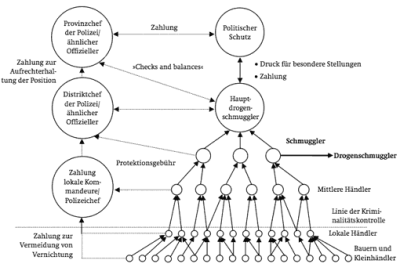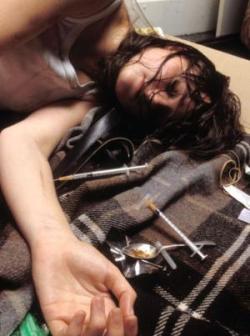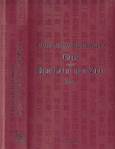War Enhancer II: Dritter Opiumkrieg
Volker Bräutigam in Ossietzky 8/2010
 ... Mehr als 90 Prozent des weltweit produzierten Opiums, Rohstoff für Morphium und Heroin, kommen aus Afghanistan. Anno 2008 waren es 8300 Tonnen. 95 Prozent des afghanischen Opiums werden weiterverarbeitet und ergeben 80 Tonnen hochreines Heroin, berichten die Vereinten Nationen. Fast die Hälfte, mehr als 35 Tonnen, werden laut übereinstimmenden Angaben der UNO und der russischen Drogenpolizei nach Rußland geschmuggelt; ein erheblicher Teil davon wandert vermutlich weiter in die urbanen Zentren Chinas.
... Mehr als 90 Prozent des weltweit produzierten Opiums, Rohstoff für Morphium und Heroin, kommen aus Afghanistan. Anno 2008 waren es 8300 Tonnen. 95 Prozent des afghanischen Opiums werden weiterverarbeitet und ergeben 80 Tonnen hochreines Heroin, berichten die Vereinten Nationen. Fast die Hälfte, mehr als 35 Tonnen, werden laut übereinstimmenden Angaben der UNO und der russischen Drogenpolizei nach Rußland geschmuggelt; ein erheblicher Teil davon wandert vermutlich weiter in die urbanen Zentren Chinas.
Allein nach Rußland gelangt demnach fast dreimal so viel Heroin wie in die USA, nach Kanada und Westeuropa zusammen. Victor Ivanov, Leiter des Föderalen Dienstes für Drogenkontrolle, erklärte im NATO-Rußland-Rat am 23. März in Brüssel, der Drogenzustrom aus Afghanistan sprenge alle Vorstellungen. Eine Million Menschen seien seit 2001, dem Jahr des Kriegsbeginns und der Besetzung Afghanistans durch US- und NATO-Truppen, schon an den Opiaten vom Hindukusch gestorben...
 Ivanov schlug dem NATO-Rußland-Rat vor, mindestens 25 Prozent der afghanischen Mohnanbaufläche zerstören zu lassen. Die NATO lehnte jedoch ab. NATO-Sprecher James Appathurai äußerte vor Journalisten zynisch: »Wir können nicht die einzige Einkommensquelle für Menschen versiegeln, die im zweitärmsten Land der Welt leben, wenn wir ihnen keine Alternative zu bieten haben.« Als ob die Besatzer aus sozialen Motiven die Opiumproduktion schützten.
Ivanov schlug dem NATO-Rußland-Rat vor, mindestens 25 Prozent der afghanischen Mohnanbaufläche zerstören zu lassen. Die NATO lehnte jedoch ab. NATO-Sprecher James Appathurai äußerte vor Journalisten zynisch: »Wir können nicht die einzige Einkommensquelle für Menschen versiegeln, die im zweitärmsten Land der Welt leben, wenn wir ihnen keine Alternative zu bieten haben.« Als ob die Besatzer aus sozialen Motiven die Opiumproduktion schützten.
Vor dem Krieg, unter dem Taliban-Regime, war Mohnanbau in Afghanistan streng kontrolliert, Mohn war nur als Lebensmittel erlaubt. Auf Drogenherstellung und -vertrieb stand die Todesstrafe. Im vorigen Jahr wurde auf dem afghanischen Markt Mohn für 3,4 Milliarden US-Dollar umgeschlagen (Quelle: Julien Mercille, Universität Dublin). 21 Prozent davon verblieben den Bauern, 75 Prozent strichen die korrupten Verbündeten der USA und der NATO ein: Regierungsbeamte, lokale Polizei, regionale Händler und Spediteure. Vier Prozent fielen für die Taliban ab, geduldet von der NATO. Denn der Gegner muß erhalten werden – im Interesse ständiger US-Präsenz. Mache sich jeder seinen Reim drauf...
__________________________________
Bei DocumentaryHeaven finden Sie:
Afghanistan: Drugs, Guns and Money
 Narrated by Colin Friels and produced by Chris Hilton, Afghanistan: Drugs, Guns and Money asks these difficult questions by following the journey of this years opium crops, tracing the drug trafficking routes heading north from Afghanistan through the nations of the Old Silk Road on its way to Europe.
Narrated by Colin Friels and produced by Chris Hilton, Afghanistan: Drugs, Guns and Money asks these difficult questions by following the journey of this years opium crops, tracing the drug trafficking routes heading north from Afghanistan through the nations of the Old Silk Road on its way to Europe.
The film examines who are the winners and losers as the crop finds its way to market. The awesome beauty of the landscape provides a powerful backdrop for the treachery uncovered each step of the way.
Like a cancer, the heroin trade has spread its tentacles through almost every level of society. In Afghanistan there is mass local addiction, local HIV epidemics, an unending cycle of violence and crime, and the corruption of state institutions.
With the war on terror raging, the war on drugs has slipped down the priority list of the current US administration. But, in the crucial frontline states of Central Asia, these two wars are inextricably linked… a fact all too often ignored.
The business is booming. Afghanistan and its near neighbors still supply around 80 per cent of the heroin sold in Western Europe. Yesterday’s drug lords are today’s cabinet ministers. How much of a problem is it for America (and the West) that many of its newest allies are implicated in one of the most lucrative drug routes in the world?
 ... Mehr als 90 Prozent des weltweit produzierten Opiums, Rohstoff für Morphium und Heroin, kommen aus Afghanistan. Anno 2008 waren es 8300 Tonnen. 95 Prozent des afghanischen Opiums werden weiterverarbeitet und ergeben 80 Tonnen hochreines Heroin, berichten die Vereinten Nationen. Fast die Hälfte, mehr als 35 Tonnen, werden laut übereinstimmenden Angaben der UNO und der russischen Drogenpolizei nach Rußland geschmuggelt; ein erheblicher Teil davon wandert vermutlich weiter in die urbanen Zentren Chinas.
... Mehr als 90 Prozent des weltweit produzierten Opiums, Rohstoff für Morphium und Heroin, kommen aus Afghanistan. Anno 2008 waren es 8300 Tonnen. 95 Prozent des afghanischen Opiums werden weiterverarbeitet und ergeben 80 Tonnen hochreines Heroin, berichten die Vereinten Nationen. Fast die Hälfte, mehr als 35 Tonnen, werden laut übereinstimmenden Angaben der UNO und der russischen Drogenpolizei nach Rußland geschmuggelt; ein erheblicher Teil davon wandert vermutlich weiter in die urbanen Zentren Chinas.Allein nach Rußland gelangt demnach fast dreimal so viel Heroin wie in die USA, nach Kanada und Westeuropa zusammen. Victor Ivanov, Leiter des Föderalen Dienstes für Drogenkontrolle, erklärte im NATO-Rußland-Rat am 23. März in Brüssel, der Drogenzustrom aus Afghanistan sprenge alle Vorstellungen. Eine Million Menschen seien seit 2001, dem Jahr des Kriegsbeginns und der Besetzung Afghanistans durch US- und NATO-Truppen, schon an den Opiaten vom Hindukusch gestorben...
 Ivanov schlug dem NATO-Rußland-Rat vor, mindestens 25 Prozent der afghanischen Mohnanbaufläche zerstören zu lassen. Die NATO lehnte jedoch ab. NATO-Sprecher James Appathurai äußerte vor Journalisten zynisch: »Wir können nicht die einzige Einkommensquelle für Menschen versiegeln, die im zweitärmsten Land der Welt leben, wenn wir ihnen keine Alternative zu bieten haben.« Als ob die Besatzer aus sozialen Motiven die Opiumproduktion schützten.
Ivanov schlug dem NATO-Rußland-Rat vor, mindestens 25 Prozent der afghanischen Mohnanbaufläche zerstören zu lassen. Die NATO lehnte jedoch ab. NATO-Sprecher James Appathurai äußerte vor Journalisten zynisch: »Wir können nicht die einzige Einkommensquelle für Menschen versiegeln, die im zweitärmsten Land der Welt leben, wenn wir ihnen keine Alternative zu bieten haben.« Als ob die Besatzer aus sozialen Motiven die Opiumproduktion schützten.Vor dem Krieg, unter dem Taliban-Regime, war Mohnanbau in Afghanistan streng kontrolliert, Mohn war nur als Lebensmittel erlaubt. Auf Drogenherstellung und -vertrieb stand die Todesstrafe. Im vorigen Jahr wurde auf dem afghanischen Markt Mohn für 3,4 Milliarden US-Dollar umgeschlagen (Quelle: Julien Mercille, Universität Dublin). 21 Prozent davon verblieben den Bauern, 75 Prozent strichen die korrupten Verbündeten der USA und der NATO ein: Regierungsbeamte, lokale Polizei, regionale Händler und Spediteure. Vier Prozent fielen für die Taliban ab, geduldet von der NATO. Denn der Gegner muß erhalten werden – im Interesse ständiger US-Präsenz. Mache sich jeder seinen Reim drauf...
__________________________________
Bei DocumentaryHeaven finden Sie:
Afghanistan: Drugs, Guns and Money
 Narrated by Colin Friels and produced by Chris Hilton, Afghanistan: Drugs, Guns and Money asks these difficult questions by following the journey of this years opium crops, tracing the drug trafficking routes heading north from Afghanistan through the nations of the Old Silk Road on its way to Europe.
Narrated by Colin Friels and produced by Chris Hilton, Afghanistan: Drugs, Guns and Money asks these difficult questions by following the journey of this years opium crops, tracing the drug trafficking routes heading north from Afghanistan through the nations of the Old Silk Road on its way to Europe.The film examines who are the winners and losers as the crop finds its way to market. The awesome beauty of the landscape provides a powerful backdrop for the treachery uncovered each step of the way.
Like a cancer, the heroin trade has spread its tentacles through almost every level of society. In Afghanistan there is mass local addiction, local HIV epidemics, an unending cycle of violence and crime, and the corruption of state institutions.
With the war on terror raging, the war on drugs has slipped down the priority list of the current US administration. But, in the crucial frontline states of Central Asia, these two wars are inextricably linked… a fact all too often ignored.
The business is booming. Afghanistan and its near neighbors still supply around 80 per cent of the heroin sold in Western Europe. Yesterday’s drug lords are today’s cabinet ministers. How much of a problem is it for America (and the West) that many of its newest allies are implicated in one of the most lucrative drug routes in the world?
gebattmer - 2010/04/20 18:29



























































Sehr interessant!